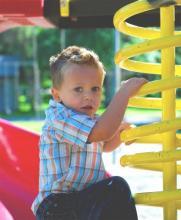
Fear is a distressing response to a perceived danger, whether real or imaginary.1 Physical responses to fear may result in an accelerated heart rate and breathing, sweaty hands, nausea, headaches, stomach aches, and nervous movements. Emotionally, children may become clingy, impulsive, or distracted, and they may suffer from disturbed sleep patterns.2
Fears play a major role in children’s lives. In today’s more challenging world, children are living with much more insecurity and uncertainty than in the past.3 For children to experience anxiety is not only normal, but it is also necessary. Dealing with fears helps prepare children to handle the unsettling challenges of life. Feeling a bit anxious can actually help children become alert and focused and help them behave in a safe way.4
Infants exhibit three basic fears: sudden motion, loud or abrupt noises, and sudden approach. They become clingy and experience stranger anxiety when confronted with people they don’t know. They also experience separation anxiety around the age of 10 months when one or both parents leave. Toddlers gradually outgrow these fears as their social worlds expand with more interaction with other familiar adults.5
As children reach the ages of 4 and 5, their imaginations develop, and they express fear of both imagined and real circumstances. Common imaginary fears are fears of monsters and of the dark. These normal fears generally do not disrupt a child’s life and occur at certain times like at bedtime. These fears are a result of the difficulty young children have in distinguishing between the real and the imaginary. As they get older, children are better able to make the distinction between reality and “make believe.” They also develop a greater sense of predictability of their environment and their ability of control it, which lessens the effects of fears.6
Children aged 7 through 12 express fears that reflect real circumstances that might happen to them, such as natural disaster and bodily injury.7 School-age children often have to deal with fears of embarrassment or rejection and may be subjected to bullying. Many children have to be home alone after school, and exposure to news media reporting makes children more aware of the dangers in the world.8 If children live in a secure environment, they will learn to work through their fears and cope with them in positive ways. However, if children have been exposed to traumatic situations like abuse or violence, their fears will not typically disappear with age and can result in long-term effects that require professional help.9
Children have an innate need to seek and explore their environment. While playing outdoors children naturally love to climb, whether on playground equipment or up a tree. While they have no fear climbing up, many children discover a real fear of heights when they reach the top, and lack the ability to know how to get back down. As children have more climbing experiences and develop their motor skills, they tend to learn to cope with their fear of heights. Children need to assume reasonable risks in order to develop cognitive and locomotor skills.10
- 1. “Fear.” Dictionary.com. < http://dictionary.reference.com/browse/fear > 19 Oct. 2010.
- 2. “Anxiety, Fears, and Phobias.” KidsHealth from Nemours. < http://kidshealth.org/PageManager.jsp?dn=KidsHealth&lic=1&ps=107&cat_id=145&article_set=21758 > 19 Oct. 2010.
- 3. “Fear and Children. Who’s Afraid of the Big, Bad Wolf?!” NotAlone.com. < http://www.enotalone.com/article/2307.html > 19 Oct. 2010.
- 4. Op. cit., “Anxiety, Fears, and Phobias.”
- 5. Gebeke, Deb. “Children and Fear.” North Dakota State University. < http://www.ag.ndsu.edu/pubs/yf/famsci/he458w.htm > 19 Oct. 2010.
- 6. “Persistent Fear and Anxiety Can Affect Young Children’s Learning and Development: Working Paper No. 9.” National Scientific Council on the Developing Child. < http://www.developingchild.net > 19 Oct. 2010.
- 7. Op. cit., “Anxiety, Fears, and Phobias.”
- 8. “Understanding Children. Fears.” Iowa State University Extension. < http://www.extension.iastate.edu/Publications/PM1529D.pdf > 19 Oct. 2010.
- 9. Op. cit., “Persistent Fear and Anxiety Can Affect Young Children’s Learning and Development: Working Paper No. 9.”
- 10. Frost, Joe L., Pei-San Brown, John A. Sutterby, Candra D. Thornton. The Developmental Benefits of Playgrounds. Olney, MD: Association for Childhood Education International, 2004. pp. 58, 70.

